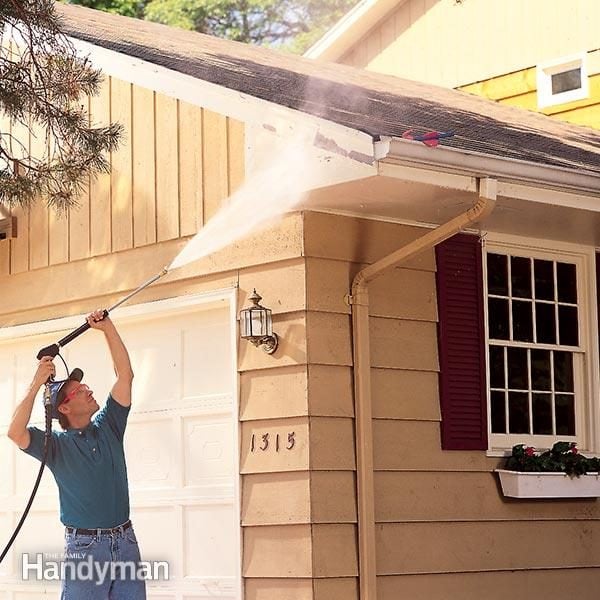A pressure washer cleans up old paint quick (House Washing). Here’s how to pressure wash your entire home so that the new coat of exterior paint will stick much better and last longer. By the Do It Yourself experts of The Family Handyman MagazineYou may also like: TBDA pressure washer is among the very best time-saving tools to come along in years.
Pros like pressure washers not only due to the fact that they’re fast, however because they search the old paint so the new coat will adhere much better. Utilizing a pressure washer to eliminate paint is certainly beats the old garden hose, scrub brush and TSP cleansing method, a task so slow that lots of people simply avoid it.
If you’re lucky and your paint is sound (no peeling), pressure washing may be the only preparation work required. Rub your turn over the painted surface area and look for a powdery light-colored residue, the sure indication of chalking. Pressure-washing will scour it off to make sure a great bonding surface area for the new coat.
A pressure washer stands out at scouring away dirt, gunk and specifically chalking, the powdery pigment left on the surface area when old oil and some latex paints deteriorate. The scouring action is so strong that you won’t need a cleanser (TSP or non-phosphate alternative) like you would if you cleaned the surface area by hand.
The Facts About Exterior Cleaning Uncovered

And then rub the paint surface area to look for chalking (Picture 1). If the previous coating was 100-percent acrylic latex paint, it probably won’t chalk. If the painted surface is tidy and not chalking, pressure cleaning is optional (Power Washing). However the majority of pros do it anyhow to make certain the new paint will adhere well.
The high pressure can easily gouge wood siding or knock the mortar from in between bricks. Besides, the pressure washer can’t do a complete scraping job. You’ll have to remove extra paint anyhow, so you will not conserve much time. Pressure cleaning works on wood, vinyl, aluminum siding and masonry, but due to its high pressure, we don’t suggest it for hardboard siding. Power Washing.
Pressure washing will not stop mildew. (It’ll clean many of it away, but the mildew will quickly grow back.) Mildew looks like a dirty-looking blackened location. To determine it, apply a little bleach. If the black areas disappear, you have mildew. Using a scrub brush instead of the pressure washer, clean the area with a mixture of 1 part bleach to 9 parts water.
Caution: Pressure washing is not a safe paint preparation method if the exterior paint includes lead. If your house was built prior to 1978 (when lead paint for domestic real estate was prohibited) or if you’re uncertain, have your paint evaluated or call your regional health department for safe handling directions. Connect the pressure washer to the outdoor faucet through a normal garden hose, attach a nozzle (see “Choosing the Finest Nozzle,” below) and start the engine.
10 Simple Techniques For Power Washing
You WILL get damp. Spread old sheets or painter’s cloths on the ground and over bushes to capture paint chips. Rent a washer that produces a minimum of 2,000 psi (pounds per square inch) of pressure. It’ll cost about $70 to $100 daily, and anticipate to keep it for a complete day.
The washer will probably be gas-powered and weigh more than 75 lbs. Depending on its size, you might need a pickup or van to carry it and help to unload it. Ask the rental representative to show you how to hook it up and run it, and to examine security precautions with you – Building Washing.
Don’t point them at anyone or try to wash your hands or feet. They can tear your skin straight off. If you do not feel great operating it, work with a pro. Finally, ensure you get a 6- to 12-ft. extension wand to help reach high locations (Image 9). Pressure washers generally have 3 or four nozzles with spray patterns of differing widths.
The spray needs to clean away all dirt and chalk without harming the siding. Rub the surface area with a clean glove to make sure the chalk comes off. If it doesn’t, try a nozzle with a narrower pattern. Do not utilize the narrow, zero-degree nozzle. It’s powerful and can quickly damage wood, stucco and other materials (Image 7).
More About Pressure Washing
Hold the wand with two hands and move it across the siding from side to side at a consistent rate. Start about 2 ft. from the siding, then move better until you find the optimum cleansing range. In general, work at a horizontal or somewhat down angle to avoid driving water up under the siding.
Wash the gutters and soffits in addition to the siding. Direct the spray far from breakable things like windows and outside lights, and eliminate home numbers and window boxes whenever possible. Pressure washers will eliminate loose paint, but they’re not a substitute for scraping (Commercial Cleaning). We’ll have to scrape additional loose paint after pressure washing this location anyway.
We’ll have to fill this location with wood putty before repainting. Gouging is unavoidable if you try to strip paint. Gutter Cleaning. Direct the nozzle away from windows, holding the wand at an angle so you don’t drive water into joints, gaps or against the glass. However, check the sill on the inside and dry up any water that dripped through.

Utilize an adjustable extension wand (6 to 12 ft.) to wash high locations. At complete length, the wand takes some muscle to handle. Excellent control takes some practice, however it’s much safer than pressure cleaning from a ladder. Remember to close all the windows!Clean high locations beyond the reach of the pressure washer extension with a scrub brush and a service of detergent and TSP blended in water.